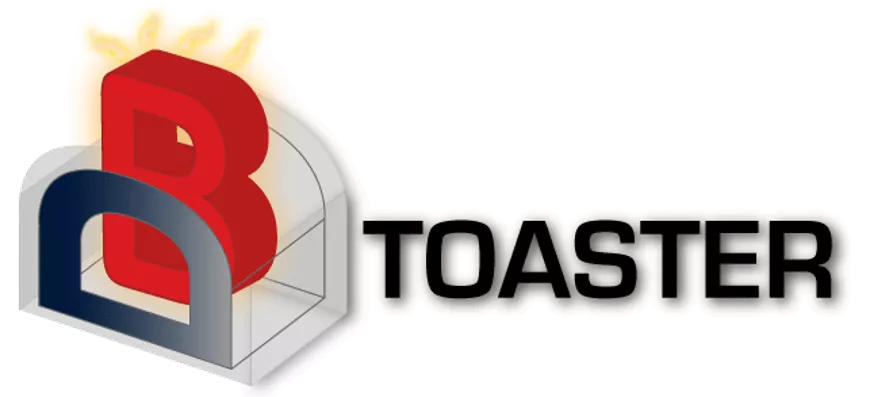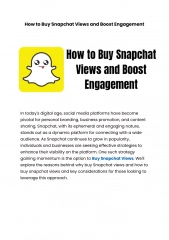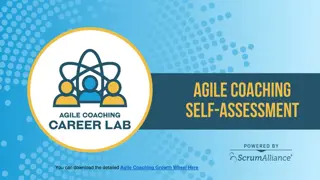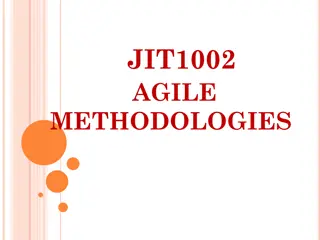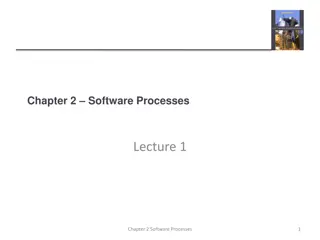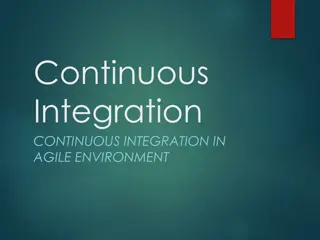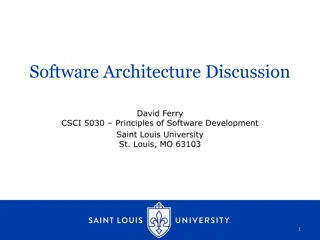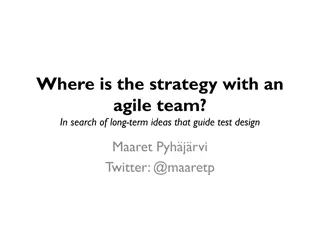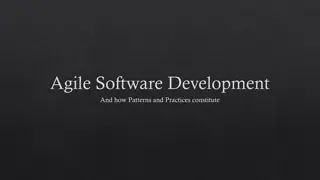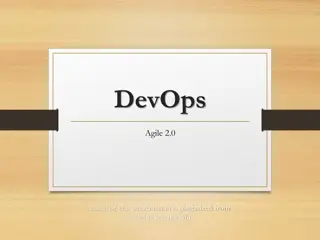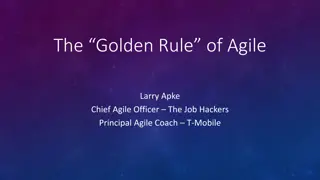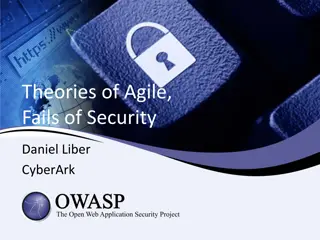Dynamic Data Management Systems in Agile Views
Large, dynamic data user and enterprise-generated data are increasingly popular, leading to the need for better data management systems. Today's approaches involve handling evolving datasets, algorithmic trading, log analysis, and more. The DBToaster project focuses on lightweight systems for managing large, dynamic datasets efficiently.
Download Presentation

Please find below an Image/Link to download the presentation.
The content on the website is provided AS IS for your information and personal use only. It may not be sold, licensed, or shared on other websites without obtaining consent from the author. Download presentation by click this link. If you encounter any issues during the download, it is possible that the publisher has removed the file from their server.
E N D
Presentation Transcript
Agile Views in a Dynamic Data Management System Oliver Kennedy1+3, Yanif Ahmad2, Christoph Koch1 yanif@jhu.edu, {oliver.kennedy,christoph.koch}@epfl.ch EPFL1, Johns Hopkins University2, Cornell University3
Large, Dynamic Data User and enterprise-generated data and analytics are gaining popularity Generating data has never been easier Applications are often long-running, and supported by evolving datasets Application examples Algorithmic trading on order books Log analysis (web servers, search engines, clickstreams, etc.) Status feeds (FB, Twitter, etc.) Enterprise monitoring: workflow and infrastructure auditing and analysis Challenge: databases are poor at handling many modifications on big data We have many techniques to improve query processing, what about update processing?
Todays Approaches to Large, Dynamic Data Applications: Dataset size or rate Architectures: Exa 4 1. Algorithmic trading 2. Algo simulation and backtesting Stream engines Main-memory DBMS Peta 6 2 Parallel DBMS, MPP 5 Tera 3. LHC (monitoring) 4. LHC (analysis) Standard DBMS 1 3 Giga 5. Google Caffeine 6. Google crawler and indexer Data ingestion frequency << 1 s Minutes Nightly Monthly Seconds Hourly Weekly Scale out on dataset size: Scale up on dataset evolution: Map-reduce, key-value stores Stream, complex event engines Communities build lightweight engines, trading off consistency for scalability Non-standard constructs (windows, formal language) Benefit from low-latency processing! These apps have large state!
Todays Approaches to Large, Dynamic Data Applications: Dataset size or rate Architectures: Exa 4 1. Algorithmic trading 2. Algo simulation and backtesting Stream engines Main-memory DBMS Peta 6 2 Parallel DBMS, MPP 5 Tera 3. LHC (monitoring) 4. LHC (analysis) Standard DBMS Ideal 13 Giga 5. Google Caffeine 6. Google crawler and indexer Data ingestion frequency << 1 s Minutes Nightly Monthly Seconds Hourly Weekly Scale out on dataset size: Scale up on dataset evolution: Map-reduce, key-value stores Stream, complex event engines Communities build lightweight engines, trading off consistency for scalability Non-standard constructs (windows, formal language) Benefit from low-latency processing! These apps have large state!
The DBToaster Project Dataset size or rate DBToaster: a simple, lightweight system to handle large, dynamic datasets (a Dynamic Data Management System) Exa Peta Tera Giga DBToaster Data ingestion frequency << 1 s Minutes Nightly Monthly Seconds Hourly Weekly Incremental data management Compilation and database synthesis Discover deep properties of queries, exploit them for scalability Automate the construction of minimal, lightweight data management tools Concerted focus on being incremental throughout the system design Related work: Starburst, Exodus, Genesis, compiling holistic plans [Arumugam et al. 10, Krikellas et al. 10], language embeddings [Meijer et al. 06, Grust et al. 10]
The DBToaster Project Dataset size or rate DBToaster: a simple, lightweight system to handle large, dynamic datasets (a Dynamic Data Management System) Exa Peta Tera Giga DBToaster Data ingestion frequency << 1 s Minutes Nightly Monthly Seconds Hourly Weekly Incremental data management Compilation and database synthesis Discover deep properties of queries, exploit them for scalability Automate the construction of minimal, lightweight data management tools Concerted focus on being incremental throughout the system design Related work: Starburst, Exodus, Genesis, compiling holistic plans [Arumugam et al. 10, Krikellas et al. 10], language embeddings [Meijer et al. 06, Grust et al. 10]
High-Frequency Orderbook Trading High-frequency algorithmic trading on order books Q1/2009: 73% of trading volume of US equities $13.4B spent worldwide on trading infrastructure, 41% in US [TABB Group, Sep 10] t = timestamp oid = order id bid = broker id p = price v = volume Order book trading Actions: Algos: insertions, deletions of bid and ask orders Exchange: matches bids and asks Bid order book (buyers) Ask order book (sellers) t oi d bi d p v t oi d bi d p v 252603 5 36721 NITE 18400 1500 252634 5 36750 GSCO 18400 1000 0 0 Electronic exchange (e.g., NYSE, NASDAQ) 252669 0 36909 MASH 18320 200 252738 9 37002 MSCO 18520 200 Queries: Algo strategies Exchange simulation for backtesting 0 0 252754 3 37001 MSCO 18270 3000 252792 8 37006 GSCO 18610 500 0 0 252832 1 37008 GSCO 18250 500 252889 4 37020 NITE 18680 500 0 0 252903 2 37011 FBCO 18190 600 252975 8 37032 MASH 18790 700 0 0 7
High-Frequency Orderbook Trading SPEs are unsuitable for general, dynamic, updates [Ahmad&Koch 09, Ghanem et al. 10] Windows couple scoping and manipulation [Botan et al. 10] t = timestamp oid = order id bid = broker id p = price v = volume Order book trading Actions: Algos: insertions, deletions of bid and ask orders Exchange: matches bids and asks Bid order book (buyers) Ask order book (sellers) t oi d bi d p v t oi d bi d p v 252603 5 36721 NITE 18400 1500 252634 5 36750 GSCO 18400 1000 0 0 Electronic exchange (e.g., NYSE, NASDAQ) 252669 0 36909 MASH 18320 200 252738 9 37002 MSCO 18520 200 Queries: Algo strategies Exchange simulation for backtesting 0 0 252792 8 37006 GSCO 18610 500 253057 4 37055 NITE 18300 300 0 0 252754 3 37001 MSCO 18270 3000 253123 0 37075 FBCO 18640 1000 0 0 252832 1 37008 GSCO 18250 500 252889 4 37020 NITE 18680 500 0 0 8 252903 2 37011 FBCO 18190 600 252975 8 37032 MASH 18790 700 0 0
High-Frequency Orderbook Trading SPEs are unsuitable for general, dynamic, updates [Ahmad&Koch 09, Ghanem et al. 10] Windows couple scoping and manipulation [Botan et al. 10] t = timestamp oid = order id bid = broker id p = price v = volume No window can enclose all updates Bid order book (buyers) Ask order book (sellers) t oi d bi d p v t oi d bi d p v No snapshot queries Lagged OLAP and nested aggregates 252603 5 36721 NITE 18400 252634 5 36750 GSCO 18400 1000 1000 0 0 Electronic exchange (e.g., NYSE, NASDAQ) SPEs rely on main- memory DBMS techniques 252669 0 36909 MASH 18320 200 252738 9 37002 MSCO 18520 200 0 0 252792 8 37006 GSCO 18610 500 253057 4 37055 NITE 18300 300 0 0 252754 3 37001 MSCO 18270 3000 253123 0 37075 FBCO 18640 1000 0 0 252832 1 37008 GSCO 18250 500 252889 4 37020 NITE 18680 500 0 0 9 252903 2 37011 FBCO 18190 600 252975 8 37032 MASH 18790 700 0 0
High-Frequency Orderbook Trading SPEs are unsuitable for general, dynamic, updates [Ahmad&Koch 09, Ghanem et al. 10] Windows couple scoping and manipulation [Botan et al. 10] Traits of DDMS apps: Access to the data is primarily by monitoring views and simple computations on them. The data store is rarely directly accessed. t = timestamp oid = order id bid = broker id p = price v = volume Bid order book (buyers) Ask order book (sellers) t oi d bi d p v t oi d bi d p v 252603 5 36721 NITE 18400 252634 5 36750 GSCO 18400 1000 1000 0 0 Electronic exchange (e.g., NYSE, NASDAQ) 252669 0 36909 MASH 18320 200 252738 9 37002 MSCO 18520 200 Materialized view maintenance dominates ad-hoc querying. 0 0 252792 8 37006 GSCO 18610 500 253057 4 37055 NITE 18300 300 0 0 252754 3 37001 MSCO 18270 3000 253123 0 37075 FBCO 18640 1000 There is usually no feedback loop. 0 0 252832 1 37008 GSCO 18250 500 252889 4 37020 NITE 18680 500 0 0 10 700 252903 2 37011 FBCO 18190 600 252975 8 37032 MASH 18790 0 0
Related Work: Incremental View Maintenance holds -14500 A view can be thought of as: a continuous query over an arbitrary database, independent of how that database is manipulated Incremental view maintenance Mechanism: delta queries Delta queries are derived by a rewrite Deltas queries, just like any other query, are processed from scratch Delta query 8 4 2 10 100 0 Base tables t oid bid p v t oi d bi d p v Well-studied from 1980s-today: 4 3 1 100 50 8 4 2 100 10 0 [Roussopoulos, 1991; Yan and Larson, 1995; Colby et al, 1996; Kotidis,Roussopoulos, 2001; Zhou et al, 2007] 2 1 1 120 50 6 5 2 150 30 3 2 1 80 10 0 11 Delta tables 7 6 1 80 50
This Talk: Agile Views Observation: delta queries are still queries, and amenable to further (delta) rewrites, leading to higher-level deltas Proposal: agile views, for as-incremental-as-possible evaluation Materialize higher-level deltas, maintain and reuse them Provide as lightweight data structures to apps, for in-process analytics Our contributions: a recursive delta compilation algorithm yielding a fully incremental query processor k-level delta is simpler (i.e. has lower degree) than (k-1)-level delta Each higher-level delta is materialized as a in-memory map, k-level map is used to maintain (k-1)-level map
Delta Queries We consider sum aggregate queries Schema: R(a,b), S(c,d) Delta queries can be represented as parameterized SQL Includes parameters or input variables Produces group-bys or output variables, and a value Similar to bound-free annotations in Datalog, and binding patterns for data integration q[][c] = select c, sum(a*e) from R, S where b < d group by c on insert S(@c,@d): qS[][c] = S(q) = select c, sum(a*@e) from R, values(@d,@e) where b < @d = select c, @e*v from (select c, sum(a) as v from R where b < @d group by c) Delta transform: standard IVM method, with nesting mS[d][c]
Incremental Trigger Programs Our query language can compose parameterized SQL, propagate parameters, and define triggers Triggers are a sequence of statements Each statement is a map update by a (materialized) delta query Statements may include loops, which are embarrassingly parallelizable Schema: Customer(custkey, name, nationkey, acctbal), Lineitem(ordkey,extprice), Orders(custkey,ordkey,sprior) on_insert_lineitem(ok,ep) { } on_insert_order(ck,ok,sp) { m[][ok, sp] += mco[][ok] * mo[][ck]; ml[][ok, sp] += mo[][ck]; mc[][ck, ok, sp] += mco[][ok]; mcl[][ck, ok, sp] += 1; } select l.ordkey, o.sprior, sum(l.extprice) from Orders o, Lineitem l where l.ordkey = o.ordkey group by l.ordkey, o.sprior
Compiling to Incremental Programs q = select l.ordkey, o.sprior, sum(l.extprice) from Lineitem l, Orders o where l.ordkey = o.ordkey group by l.ordkey, o.sprior; Query Map signature q m[][ordkey,sprior]
Compiling to Incremental Programs q = select l.ordkey, o.sprior, sum(l.extprice) from Lineitem l, Orders o where l.ordkey = o.ordkey group by l.ordkey, o.sprior; Query Map signature q m[][ordkey,sprior] Level 1: +L(@ok,@ep) : m[][ordkey,sprior] += L(q); +O(@ck2,@ok2,@sp) : m[][ordkey,sprior] += O(q);
Compiling to Incremental Programs q = select l.ordkey, o.sprior, sum(l.extprice) from Lineitem l, Orders o where l.ordkey = o.ordkey group by l.ordkey, o.sprior; Query Map signature q m[][ordkey,sprior] Level 1: +L(@ok,@ep): m[][ordkey,sprior] += select l.ordkey, o.sprior, sum(l.extprice) from values(@ok,@ep) as l(ordkey,extprice), Orders o where l.ordkey = o.ordkey group by l.ordkey, o.sprior
Compiling to Incremental Programs q = select l.ordkey, o.sprior, sum(l.extprice) from Lineitem l, Orders o where l.ordkey = o.ordkey group by l.ordkey, o.sprior; Query Map signature q m[][ordkey,sprior] ql = L(q) ml[][ordkey,sprior] Level 1: +L(@ok,@ep): m[][ordkey,sprior] += select l.ordkey, o.sprior, sum(l.extprice) from values(@ok,@ep) as l(ordkey,extprice), Orders o where l.ordkey = o.ordkey group by l.ordkey, o.sprior simplify => select @ok, sprior, @ep*v from (select o.sprior, sum(1) as v from Orders o where @ok = o.ordkey group by o.sprior) ml[][@ok,sprior]
Compiling to Incremental Programs q = select l.ordkey, o.sprior, sum(l.extprice) from Lineitem l, Orders o where l.ordkey = o.ordkey group by l.ordkey, o.sprior; Query Map signature q m[][ordkey,sprior] ql = L(q) ml[][ordkey,sprior] Level 1: +L(@ok,@ep): m[][@ok,sprior] += @ep * ml[][@ok, sprior];
Compiling to Incremental Programs q = select l.ordkey, o.sprior, sum(l.extprice) from Lineitem l, Orders o where l.ordkey = o.ordkey group by l.ordkey, o.sprior; Query Map signature q m[][ordkey,sprior] ql = L(q) ml[][ordkey,sprior] Level 1: +L(@ok,@ep): foreach sprior in ml: m[][@ok,sprior] += @ep * ml[][@ok, sprior]; In this talk, we ll use our syntax with implicit for loops everywhere: +L(@ok,@ep): m[][@ok,sprior] += @ep * ml[][@ok, sprior];
Compiling to Incremental Programs q = select l.ordkey, o.sprior, sum(l.extprice) from Lineitem l, Orders o where l.ordkey = o.ordkey group by l.ordkey, o.sprior; Query Map signature q m[][ordkey,sprior] ql = L(q) ml[][ordkey,sprior] Level 1: +L(@ok,@ep): m[][@ok,sprior] += @ep * ml[][@ok, sprior]; We must recursively maintain this map!
Compiling to Incremental Programs ql = select o.sprior, sum(1) as v from Orders o where @ordkey = o.ordkey group by o.sprior Query Map signature q m[][ordkey,sprior] ql = L(q) ml[][ordkey,sprior] Level 1: +L(@ok,@ep): m[][@ok,sprior] += @ep * ml[][@ok, sprior]; Level 2: +O(@ck2,@ok2,@sp) : ml[][ordkey,sprior] += O(ql);
Compiling to Incremental Programs ql = select o.sprior, sum(1) as v from Orders o where @ordkey = o.ordkey group by o.sprior Query Map signature q m[][ordkey,sprior] ql = L(q) ml[][ordkey,sprior] +L(@ok,@ep): m[][@ok,sprior] += @ep * ml[][@ok, sprior]; Level 2: +O(@ck2,@ok2,@sp) : ml[][ordkey,sprior] += select o.sprior, sum(1) from values(@ck2,@ok2,@sp) as o(custkey,ordkey,sprior) where @ordkey = o.ordkey group by o.sprior select @sp, 1 where @ordkey = @ok2 group by @sp =>
Compiling to Incremental Programs ql = select o.sprior, sum(1) as v from Orders o where @ordkey = o.ordkey group by o.sprior Query Map signature q m[][ordkey,sprior] ql = L(q) ml[][ordkey,sprior] +L(@ok,@ep): m[][@ok,sprior] += @ep * ml[][@ok, sprior]; Level 2: +O(@ck2,@ok2,@sp) : ml[][@ok2, @sp] += 1; Independent of database! Compilation terminates
Recursive Delta Compilation Compilation terminates: on_insert_lineitem(ordkey, extprice) { q[][ordkey, sprior] += extprice*ql[][ordkey, sprior]; For a query q: deg( (q)) = max(0, deg(q)-1) (think degree of polynomial when taking derivatives) qo[][ordkey] += extprice; } Deltas are eventually independent of the database, and depend only on the update, i.e. for some k: deg( k(q)) = 0 on_insert_order( custkey, ordkey, sprior) { q[][ordkey, sprior] += qo[][ordkey]; ql[][ordkey, sprior] += 1; }
Recursive Delta Compilation on_insert_customer(ck,nm,nk,bal) : m[][ordkey, sprior] += mc[][ck, ordkey, sprior]; ml[][ordkey, sprior] += mcl[][ck, ordkey, sprior]; mo[][ck] += 1; select l.ordkey, o.sprior, sum(l.extprice) from Customer c, Orders o, Lineitem l where c.custkey = o.custkey and l.ordkey = o.ordkey group by l.ordkey, o.sprior; on_insert_lineitem(ok,ep) : m[][ok, sprior] += ep * ml[][ok, sprior]; mc[][custkey, ok, sprior] += ep * mcl[][custkey, ok, sprior]; mco[][ok] += ep; on_insert_order(ck,ok,sp) : m[][ok, sp] += mco[][ok] * mo[][ck]; ml[][ok, sp] += mo[][ck]; mc[][ck, ok, sp] += mco[][ok]; mcl[][ck, ok, sp] += 1;
Compilation Framework (v.4) Unifies, eliminates variables Minimizes propagation Handles nested query deltas Initial value computation Map Parser declaration 1 2 1 Trigger construction Preaggregation Delta rewrite Simplification Materialization Databases as rings: incremental program construction Low-level engine compilation (v.3) Assume Q1, Q2,Q3 are SPJ-queries: 1. Recursively polynomial form: (select x, sum(t) from Q1 g.b. x) * (select y, sum(t) from Q2 g.b. y) + (select x, y sum(t) from Q3 g.b. x,y) 2. Nested aggregate normal form: (select x, sum(v) from (select x,y,sum(t) as v from Q1) g.b. x) * (((select sum(t) from Q2 where f(x, ) 0) < 0)
Ongoing Work: Low-Level Query Evaluation Challenge: create a customized, lightweight engine to evaluate delta queries How do we incorporate PL and compiler research to specialize? Our approach: use a simple functional language for lower-level plans A whole-query representation facilitating powerful transformations of physical aspects of query processing (pipelining vs. blocking, memoization, etc.) Our functional language: K3, supports structural recursion [Buneman et al. 95] Functional primitives on nested collections, forming a monad Shown to be as expressive as nested relational algebra and comprehensions (e.g. LINQ, Ferry [Meijer et al. 06, Grust et al. 10]) Core primitives: map, flatten, aggregate (w/ group-bys), persistent collections
Structural Plans with Nested Collections Schema: R(a,b), S(c,d,e), T(f,g) Query: SELECT sum(a*g) FROM R,S,T; K3 unoptimized: aggregate(fun < <x,y>, z>. (x*y)+z, 0, flatten( map(fun <x>. map(fun <f,g>.<x,g>, T[][fg]), flatten( map(fun <a,b>. map(fun <c,d,e>.<a>, S[][cde]), R[][ab]))))) T R S
Structural Plans with Nested Collections Schema: R(a,b), S(c,d,e), T(f,g) Query: SELECT sum(a*g) FROM R,S,T; K3 unoptimized: aggregate(fun < <x,y>, z>. (x*y)+z, 0, flatten( map(fun <x>. map(fun <f,g>.<x,g>, T[][fg]), flatten( map(fun <a,b>. map(fun <c,d,e>.<a>, S[][cde]), R[][ab]))))) T R S K3 optimized: aggregate(fun < <x,y>, z>. (x*y)+z, 0, flatten(flatten( map(fun <a,b>. map(fun <c,d,e>. map(fun <f,g>. <a,g>, T[][fg]), S[][cde]), R[][ab])))) R S T K3 provides a clean framework for mixing tuple- and set-at-a-time processing: eliminates temporaries (intermediates) via function composition and inlining, and abstracts: i) blocking vs. pipelining via map primitive, ii) 1NF construction with flatten
Storage Challenge: design external map layouts, and data structures based on incremental program access workload aggregate(fun < <x,y>, z>. (x*y)+z, 0, flatten(flatten( map(fun <a,b>. map(fun <c,d,e>. map(fun <f,g>. <a,g>, T[][fg]), S[][cde]), R[][ab])))) K3 provides a unified representation of query temporary and storage layouts Abstracts implementation of nesting, e.g. via pointers in main-memory or clustering/linearization Many benefits: simpler DB internals, common optimizer framework for queries and layouts Other issues: Language support for index representations (via variant datatypes) and denormalization
Storage Challenge: design external map layouts, and data structures based on incremental program access workload aggregate(fun < <x,y>, z>. (x*y)+z, 0, flatten(flatten( map(fun <a,b>. map(fun <c,d,e>. map(fun <f,g>. <a,g>, T[][fg]), S[][cde]), R[][ab])))) K3 provides a unified representation of query temporary and storage layouts Abstracts implementation of nesting, e.g. via pointers in main-memory or clustering/linearization Many benefits: simpler DB internals, common optimizer framework for queries and layouts Storage section annotation aggregate(fun < <x,y>, z>. (x*y)+z, 0, flatten(flatten( map(fun <a,b>. map(fun <c,d,e>. map(fun <f,g>. <a,g>, T[][fg]), disk{ map(fun <e>. map(fun <c,d>. <c,d,e>, S.CD[][cd]), S.E[][e]) }), R[][ab])))) Other issues: Language support for index representations (via variant datatypes) and denormalization
Ongoing Work: Incremental Processing in the Cloud Cumulus: facilitates large, shared-nothing main- memory trigger processing Exploit embarrassingly parallelizable trigger programs Map entry updates in a trigger are independent Subclass of our query language (no nesting, only equijoins) yields programs with NC0 parallel complexity [Koch 10] Consistency requirement: prior state must be consistent before processing an update Na ve approach: serial, atomic trigger execution DBToaster Cumulus: a distributed main-memory DDMS Our approach: bounded out-of-order processing Computation performed on out-of-order events is simple, just evaluate delta queries Easy to realize eventual consistency via loosely coordinated, distributed incremental processing
Incremental Processing in the Cloud Cumulus: facilitates large, shared-nothing main- memory trigger processing Trigger: on_insert_customer(ck,nm,nk,bal) { m[][ordkey, sprior] += m_c[][ck, ordkey, sprior]; ... } Exploit embarrassingly parallelizable trigger programs Map entry updates in a trigger are independent Subclass of our query language (no nesting, only equijoins) yields programs with NC0 parallel complexity [Koch 10] Trace: on_insert_customer(1,2,3,4): m[][1,2] += m_c... m[][3,3] += m_c... ... parallel execution within trigger Consistency requirement: prior state must be consistent before processing an update Na ve approach: serial, atomic trigger execution must consistently use prior state Our approach: bounded out-of-order processing Computation performed on out-of-order events is simple, just evaluate delta queries Easy to realize eventual consistency via loosely coordinated, distributed incremental processing on_insert_customer(5,6,7,8): m[][1,2] += m_c... m[][3,3] += m_c... ...
Incremental Processing in the Cloud Cumulus: facilitates large, shared-nothing main- memory trigger processing Exploit embarrassingly parallelizable trigger programs Map entry updates in a trigger are independent Subclass of our query language (no nesting, only equijoins) yields programs with NC0 parallel complexity [Koch 10] Consistency requirement: prior state must be consistent before processing an update Na ve approach: serial, atomic trigger execution Our approach: bounded out-of-order processing Computation performed on out-of-order events is simple, just evaluate delta queries Easy to realize eventual consistency via loosely coordinated, distributed incremental processing
Summary Many applications work with large, evolving datasets made up of both short- and long-lived items. This necessitates agile dynamic data management techniques. Three takeaways: Agile views, lightweight data structures for apps, maintained as incrementally as possible QP engine based on a functional language, to mix tuple-at-a-time and set-at-a-time processing, and specialize physical representations With an incremental core, we can develop loosely co-ordinated distributed systems mechanisms more easily We re building DBToaster, a prototype DDMS, at EPFL and JHU Language embedding, multicore, one-pass batch processing
Questions? Introducing the JHU Data Management Systems Lab http://damsel.cs.jhu.edu Current projects: DBToaster, declarative query optimization Collaborators: Randal Burns, Jason Eisner, Alex Szalay, Andreas Terzis Interests: dynamic data, declarative languages, scientific data management, data intensive computing JHU research highlights: Dyna: weighted logic programming for NLP, and generally AI algorithms Data-intensive architectures: DataScope (5 PB NSF MRI grant), GrayWulf (SC 08 Storage winner, 70GB/s), Amdahl blades Scientific datasets: PanSTARRS & SDSS, Turbulence (27TB), Life Under Your Feet, DC Genome NEW, Sigmod Record 11 article: Scientific Data Management at the Johns Hopkins Institute for Data Intensive Engineering and Science


